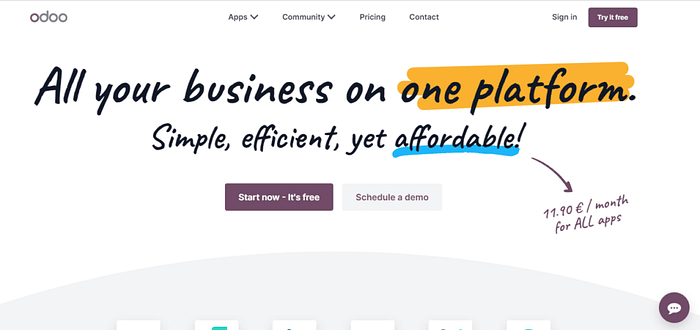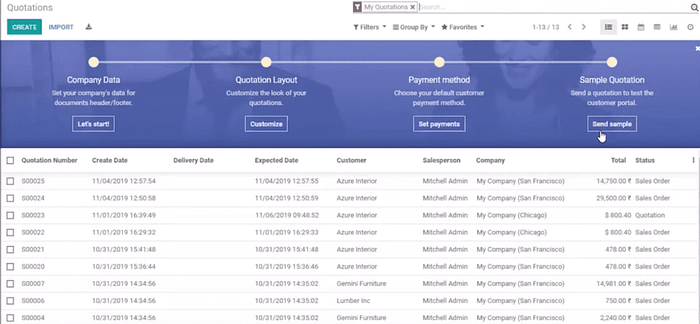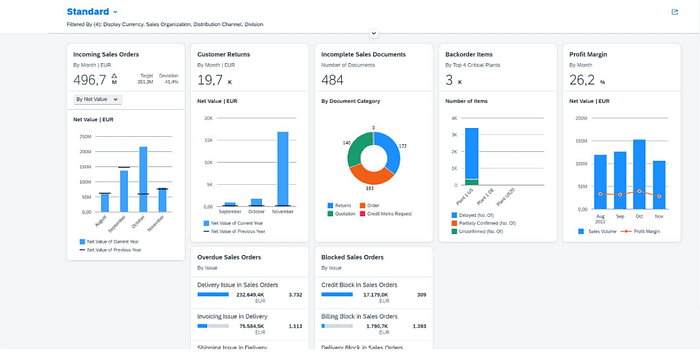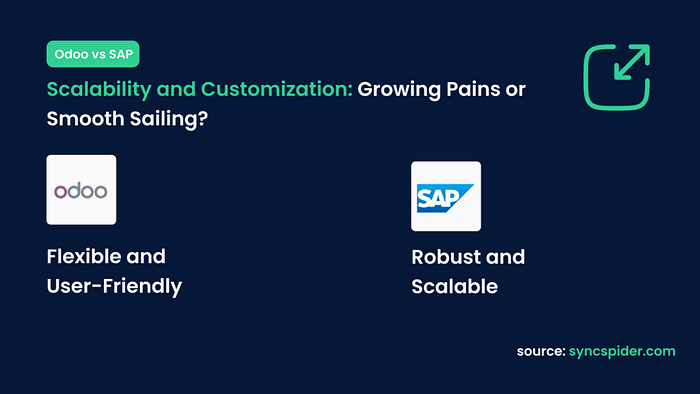Odoo vs SAP Comparison: The Two ERP Software Giants
Well, well, well, here we are together again on a new adventure named “Odoo vs SAP.” I won’t beat around the bush — gathering all this information was no small feat. My method? A rigorous regimen of trial and error, combing through endless forums, and sneak peeks at others’ experiences (to check whether it was just me stumbling or if these were genuine hurdles). And voilà! You now have an article that delves into the pros and cons of Odoo and SAP.
Let’s get acquainted with these two first (yeah, I know, you might not want that, so feel free to skip the next section and jump straight to the juicy bits)
Now, you might already be leaning towards Odoo or have your corporate tent pegged firmly in the SAP camp. If so, this article might not change your mind, but who knows? It could! Both systems have unique flavors and strengths, much like choosing between a sturdy oak-aged bourbon and a finely distilled Scotch — both will do the job, but the experience is distinctly different.
So, even if you think you’ve made up your mind, stick around — there might just be a few surprises in store for you!
Odoo vs SAP: Unpacking the Giants of ERP Software 2024
As promised, we’re going to unwrap the story about these two ERP solutions, which are garnering quite the buzz in the business world. If you’re a regular reader or subscribed to our newsletter, you probably know me as more of an eCommerce platforms explorer (and if you’re not on our mailing list, make sure to subscribe for more adventures :D). This is, I must confess, my first foray into the bustling universe of ERPs.
Now, stepping into this arena, my first question was simple: why are Odoo and SAP so popular? What’s all the fuss about?
Why Are Odoo and SAP So Popular Nowadays?
Diving headfirst into Odoo and SAP felt like exploring two vastly different planets in the ERP solar system. On the one hand, Odoo, with its user-friendly interface and modular approach, offers a flexibility that’s hard to beat. It’s like having a fully stocked toolbox for your business- whatever you need, there’s likely a tool for that. This adaptability makes it a darling among startups and mid-sized businesses that need software that can pivot as quickly as they do.

Then there’s SAP — think of it as the grand fortress of ERP systems. Its strength lies in its comprehensive integration capabilities and the robustness that large enterprises swear by. SAP is like a seasoned general who has seen many battles and knows precisely how to manage an army of business processes. Its popularity stems from its ability to handle massive, complex operations with the same finesse as managing simple tasks, making it indispensable for major corporations.
Both systems have risen to prominence not just by being good at what they do but by filling a vital niche in the business software ecosystem. Their popularity is a testament to how well they understand and address the needs of their diverse user bases. Whether you’re a nimble startup needing a customizable solution or a global enterprise looking for robust functionality, Odoo and SAP offer paths to streamlined, efficient business management.
Open Source & Public Edition, On-premises & Cloud
Okay, now it becomes tricky. When you talk about ERPs, a lot of terms just jump up, and you might want to make sure you understand what these terms mean. Let’s crack all of them.

Open Source — Free Meal or Not?
Open source means it’s free to use, right? And Odoo is an open-source ERP? Just before I started this adventure, I went to the Odoo website and found out that it has a pricing plan. (I have to say that confused me.) Later, I discovered that Odoo ERP has a unique business model combining open source and commercial elements. Smart, right?
The core of Odoo, known as Odoo Community Edition, is entirely open source. This edition allows businesses to use and modify the code without any cost, allowing all sorts of customization. It includes a wide range of business apps that are suitable for small businesses or those with limited needs.
But… yes, there’s always a “but.” If you opt for open-source software, you won’t have many things you might need for your business operations (except if you’re a developer and can manage everything yourself. Since I, your content writer, am not so tech savvy, I really didn’t want to get into the forest of codes). So, what I found out is that with this community edition (open-source ERP), you don’t have functional support, version upgrades, or hosting. And that was enough for me to switch to the Enterprise plan.
The good thing is that you have a $0 plan (yeah, it’s free!) if you’re going to use one app. What else do I need?

Public Edition — The Silver Platter of ERP?
When I first heard about the “Public Edition” of SAP S/4HANA, I thought, “Okay, what’s the catch?” It sounds like you’re getting a VIP ticket to the ERP show, but as always, it’s a bit more nuanced than that.
SAP S/4HANA Public Edition is a streamlined, polished version of SAP’s powerhouse software, designed to be easy to deploy and manage. That sounds ideal, right? Well, it is, especially if you’re part of a large enterprise that wants heavyweight performance without heavyweight hassle.
But here’s the twist: while it’s offered as a one-size-fits-all solution, it might not fit everyone perfectly. Imagine getting a custom suit off the rack — sure, it fits well enough for most, but it’s not tailored to the unique contours of your business. This edition is hosted in the cloud and managed by SAP, which means less worry about maintenance and upgrades. You get a robust, secure, and up-to-date system with limited customization compared to the full-fat versions.
So, if your business needs are straightforward or value simplicity and quick deployment over tailor-made solutions, the Public Edition could be your golden ticket. But you might find it a bit too rigid if you need something more adaptable to twist and turn with your every business whim.
On-Premises or Cloud — Choosing Your ERP Battlefield
Deciding between an on-premises or cloud setup for your ERP system can feel a bit like choosing between a fortress and an open field. Each has its strengths and suits different battle strategies (aka business operations).
- Odoo: Versatility at Your Command Odoo offers flexibility with both its Community and Enterprise editions available for on-premises and cloud deployment. If you’re the type that likes to have total control and keep all your data under lock and key, the on-premises option lets you manage everything on your own servers. This is great for businesses with specific security policies or those in industries where data residency is crucial. Meanwhile, if you prefer not to worry about the nitty-gritty of server maintenance and enjoy the freedom of scaling effortlessly, Odoo’s cloud version will be more your style. It’s like having an open field where you can quickly expand as needed without getting bogged down by physical constraints.
- SAP ERP Systems: Robust and Ready SAP offers a range of ERP solutions including the renowned SAP ECC and the newer SAP S/4HANA, all available in both on-premises and cloud versions. The on-premises deployment gives businesses the fortress-like security and control they need, with the flexibility to deeply customize and integrate with other essential systems. This option is ideal for large enterprises that require robust, tailored solutions. For those seeking less overhead in managing infrastructure, SAP’s cloud ERP solutions, like the SAP S/4HANA Cloud, offer a more streamlined approach. These cloud solutions ensure automatic updates, advanced security, and high performance, albeit with somewhat less customization flexibility than their on-premises counterparts.
Choosing between on-premises and cloud ultimately depends on your company’s size, regulatory needs, and how much control you want over your ERP environment. Each option offers its own strategic advantages, whether you prefer the solid walls of a fortress or the expansive possibilities of an open field.
SAP vs Odoo Comparison
Starting the journey is never easy, but once you dip your toe into it, you can’t stop if you’re a curious personality. So, we’ll go through some questions that I think every person would have when choosing one of these tools. This encompasses price, initial release dates, features, versions, user interface, reliability and safety, integration capabilities, scalability, support, and innovations and updates.
Roll up your sleeves; we’re in!
Heritage and Evolution: Odoo and SAP ERP Software
After getting the answer to why people are so fascinated with the two, the next question was, who’s the elder? And let me tell you why this matters. When software has been around longer, it typically means it’s more reliable (all bugs have already been fixed). On the other hand, it might lack some trendy functions, or they just came as a necessity with technological development. And what did I find?
SAP, founded in 1972, has been a heavyweight in the ERP industry, known for its robust, comprehensive solutions tailored primarily to large enterprises. Over the years, SAP has introduced various versions, including on-premises and cloud solutions, to cater to different business needs. The need for integration tools like SyncSpider becomes apparent when working with multiple versions to ensure seamless data flow between SAP and other systems.
Odoo, launched in 2005 as TinyERP, has rapidly evolved into a versatile suite known for its modular design and strong community support. From its initial versions, Odoo has expanded to offer both on-premises and cloud-based options, adapting quickly to new technological trends and user needs. Integration tools like SyncSpider are handy when customizing Odoo’s modules to work efficiently with other business systems.
What Users Have to Say
We all do it. When you’re about to buy or start using a new software, checking the reviews is a must. And that’s exactly what I did to gather insights for you. To answer the question of user satisfaction, I delved into reviews on three popular platforms: G2, GetApp, and Capterra.

SAP’s reviews range from 4.2 to 4.3 stars across about 1,500 reviews. Most users praise SAP for its reliability, stating it’s one of the most dependable ERP software solutions out there — worth every penny. This sentiment echoes the system’s robustness and its ability to handle complex business processes effortlessly. We’ll dive deeper into what makes it so valuable, especially when discussing pricing later.
Odoo, on the other hand, might be the newer kid on the block compared to SAP, but it’s quickly making a name for itself. Based on around 1,000 reviews, it boasts scores ranging from 4.1 to 4.4 stars. Many users highlight its user-friendly interface and the flexibility of its modular system, which seems to be a hit, especially among small — to medium-sized businesses.
Feature Comparison: Simplifying the Complex
When it comes to ERP features, diving deep into every single function could take us till next March, and I know you’ve got other things to do! So, for the sake of brevity (and your sanity), I’ve narrowed it down. I chose the free plan from Odoo and picked just one app — the Sales app — to test out. I did the same with SAP S/4HANA to keep things on an even keel.
Odoo’s Sales App: Flexibility Front and Center Odoo’s Sales app in the free plan is quite the toolbox for small to medium-sized businesses looking to streamline their sales processes. It offers functionalities like quotations, sales orders, and customer relationship management, all integrated into one user-friendly interface. Odoo’s modular nature means that even in the free version, you can extend capabilities relatively easily, provided you’re willing to explore additional modules at a cost.

SAP S/4HANA Sales: Enterprise Power SAP’s S/4HANA Sales module, even in a basic setup, is designed to handle complex sales structures and large volumes typical of bigger enterprises. It has advanced features and can accommodate highly complex business needs. It integrates deeply with other business functions, providing comprehensive analytics and real-time data that help make informed decisions quickly. The catch? While robust, it may require a steeper learning curve and more substantial initial investment in setup and training compared to simpler systems.

Odoo vs SAP Integration: Don’t Go It Alone
If you’ve ever thought, “I’ll integrate this ERP system with another tool myself, no big deal,” you might want to sit down for this one. Integrating ERP systems is not for the faint of heart or the casual DIYer. It’s like trying to solve a Rubik’s Cube blindfolded -possible, but why put yourself through that?
Odoo: DIY if You Dare
Integrating other apps with Odoo is technically possible on your own, but unless you’re a developer or a glutton for punishment, I’d think twice. Odoo allows self-managed integrations, which is great if you know your way around code. If you don’t, don’t worry- help is at hand. You can contact an Odoo Partner (officially listed on their site) who can manage the heavy lifting for you. Alternatively, using an integration tool like SyncSpider simplifies the process and ensures that your integrations are customized to fit your needs, with a team of developers ready to tackle any challenge.
SAP: A Heavier Lift
SAP’s integration story is a bit different. Their own platform for integration is robust and incredibly powerful, but let’s just say it’s not wallet-friendly. And trying to handle SAP integrations on your own can be a Herculean task. It’s generally time-consuming and complex, making it less than ideal for non-specialists. Like with Odoo, leveraging a tool like SyncSpider can save you time, money, and a lot of headaches. It offers a more accessible way to connect SAP with other systems, with professional support to guide you through the process.
Bottom Line
Both Odoo and SAP offer powerful integration capabilities, but the journey can be tricky. Whether it’s the open-source flexibility of Odoo or the enterprise muscle of SAP, stepping into integration without the right tools or professional help can turn into a real adventure — one you might not enjoy. So, unless you have a developer’s skillset, my advice is to get professional help or use a dedicated integration tool like SyncSpider to make your life easier.
Scalability and Customization: Growing Pains or Smooth Sailing?
While I didn’t dive into scaling the systems myself, it’s wise to start with the assumption that we’re all aiming to scale our businesses. As your company grows, you’ll need an ERP system that keeps pace and adapts to your evolving needs. Let’s explore how Odoo and SAP handle scalability and customization — two critical factors that can significantly impact whether your business experiences growing pains or enjoys smooth sailing.

- Odoo: Flexible and User-Friendly
Odoo excels in flexibility with its modular architecture. Start with the essentials and add functionalities as your business grows, fitting them seamlessly into your existing setup. Its open-source nature also allows extensive customization, enabling you to tailor the ERP to your specific needs, from tweaking the interface to developing custom modules.
- SAP: Robust and Scalable
SAP is built like a skyscraper, designed to support expansive and complex operations of large enterprises. It offers tremendous scalability but requires significant resources and expertise for customization, making it ideal for organizations that need a powerful system and are prepared to invest in tailored solutions.
The choice between Odoo and SAP for scalability and customization hinges on your business’s size, needs, and technical resources. Odoo is more flexible and easily customized, suited for dynamic businesses with unique requirements. SAP, meanwhile, is optimal for large enterprises that need a robust, scalable ERP to manage complex, large-scale operations.
What Did I Find Out
Odoo is a modular and flexible open-source ERP software that helps small and medium businesses streamline their sales (not only sales but, in this case, yes). The solution seems to be the best fit for businesses with less complex workflows, and since Odoo is highly customizable, it’s on the list of the most popular business solutions.
SAP also has its charm, especially because it can encompass a wide range of business needs, especially if you run a larger-scale business. In that case, SAP Business Suite is something that can make your life much easier. That also suggests that you have a larger budget for your ERP solution.
What I didn’t do is a price comparison. Why? Because you already know the answer. Yes, Odoo is more wallet-friendly than SAP.
So, who wins in the Odoo vs SAP comparison? I think it depends on your organization’s budget and needs. If you prioritize low cost and flexibility, Odoo might be a good fit. If you run a corporation-style business, SAP is a better fit.
— — — — — — — — — -
About the author: Kristina Radosavljević
Content writer at SyncSpider